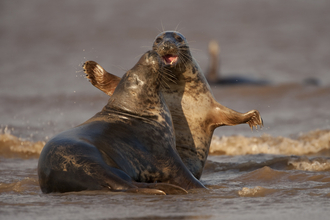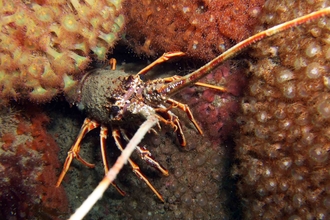
Phosphorescent sea pen ©Paul Naylor www.marinephoto.co.uk
Phosphorescent sea pen
This colonial creature looks like an old-fashioned quill - that's where the name sea pen comes from.
Scientific name
Pennatula phosphoreaWhen to see
January to DecemberSpecies information
Category
Statistics
Height: Up to 40cmConservation status
Sea pens and burrowing megafauna communities are featured on the OSPAR List of Threatened and/or Declining Species and Habitats (Region II – North Sea, Region III – Celtic Sea) and are a Feature of Conservation Importance for which Marine Conservation Zones can be designated.
Habitats
About
Did you know that sea pens are actually animals? In fact, they are very unique animals indeed. Each sea pen is a colony of mini anemone-like creatures called polyps, with all of the polyps taking a specific role within the colony. To begin with, one single polyp loses its tentacles and develops into the central stem, called the rachis (like in a feather). From this central stem grow the distinctive branch-like structures that gave sea pens their name. The bottom half of the central stem is a burrowing organ called a peduncle - this is what the sea pen uses to anchor itself into the soft seabed. As a result, they tend to live in deeper water on stable seabeds where they are less likely to be uprooted. Though they are sometimes found in sheltered harbours! Sea pens are also home to many secondary polyps that are either specialised for feeding or water intake - as water is required to keep the whole sea pen colony turgid. Sea pens are filter feeders, their special feeding polyps - called autozooids - have 8 tentacles that they use to catch plankton and other particles of food from the surrounding water. There are 3 types of sea pen found in UK seas, including the beautiful phosphorescent sea pen. As its name suggests, this sea pen glows a bluey-green colour when disturbed. The light is emitted by the polyps and pulses in waves across the sea pen. This is a kind of defence mechanism, aiming to startle and ward off predators. The Phosphorescent sea pen is a favourite food of the Dover Sole - but it is not entirely defenceless. Studies have shown that the sea pen has narcotic and appetite-diminishing properties which might deter hungry Soles from devouring them.How to identify
Sea pens are unmistakeable - they look like an old-fashioned quill stuck in the seabed! phosphorescent sea pens are pinkish with white polyps and distinctively tree-like or bushy. Slender sea pens are slender and a white-ish cream colour. Tall sea pens are unsurprisingly much taller than the others, growing to heights of up to 2m!Distribution
On the seabeds in the northern Irish Sea, northern North Sea and in Scottish sea lochs.Did you know?
If threatened, sea pens will expel the water that holds them upright and either retreat into a tube under the seabed surface or lie flat on the seabed until the danger has passed.How people can help
Mud and its special array of associated wildlife is one of the features that The Wildlife Trusts consider to have insufficient protection in UK seas. The Wildlife Trusts are calling for sea lovers from across the UK to become a Friend of Marine Conservation Zones. You can also help by choosing not to eat Scampi (it might be on the menu as Langoustine or Norway Lobster), except where it is from a certified sustainable fishery - look out for the blue MSC logo.





